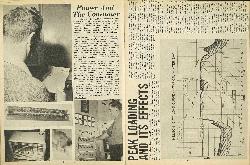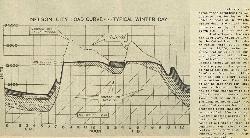41
Peak Loading and its Effects
The Nelson City Council's electricity department, which reticulates only a half of greater Nelson city, buys its power from the Waimea Power Board, which, in turn, buys from the New Zealand Electricity Department. Under this system the council's electricity department pays the power board an "on cost" charge. This has lately been reduced and it will continue to be reduced over the next five years. The power board charges out the power bought from the State at the State rate plus the, "on cost" charge. This is $23.5 per KW of the annual maximum demand, plus 27c per unit, and the "on cost" charge is calculated on these figures. The "peak load" figure is set by the electricity department. It is an informed estimate of the average amount of power to be used annually. At the moment the peak is set at 13,000 KW. The peak could be set at any figure, for example, 17,000 KW, but the department would then have to pay an additional $92,000 a year for this extra power and this increased cost would have to be passed on to the consumer and the consumer's power bill would rise considerably. The department, therefore, sets its peak at as low a figure as possible while giving due regard to keeping water heating cuts to a reasonable minimum. The loads which can be controlled are storage heating and water heating.
The graph at left was prepared by the department to illustrate peak loading and the usage of power on a typical winter day. The actual load curve is shown by the heavy black line. If there was no control of off-peak loading, the load curve would be shown by the dotted line. In order to reduce this 17,000 peak down to 13,000, water and space heating is cut off during these peak loading times, and allowed on at off-peak loading times. As can be seen from the graph, the periods at which the. load is at a low level are from about 10 pm to 7 am, and a short period in mid-afternoon. From this it can be seen that for only about two hours on this day was it found necessary to cut off all water heaters (between 7.30 am and 9.30 am). The unshaded areas below the controlled maximum load line represent power that can not be controlled (for cooking, electric heating points, industry and lighting). The point of all this is that if consumers want more water-heating time, they must then control, wisely, power gulp-ers such as heaters.




